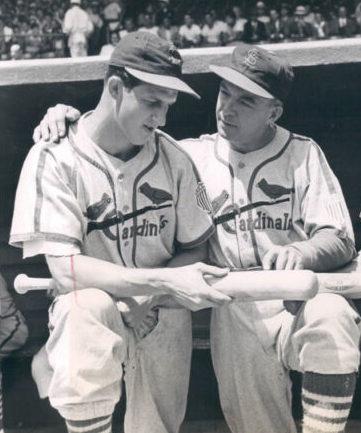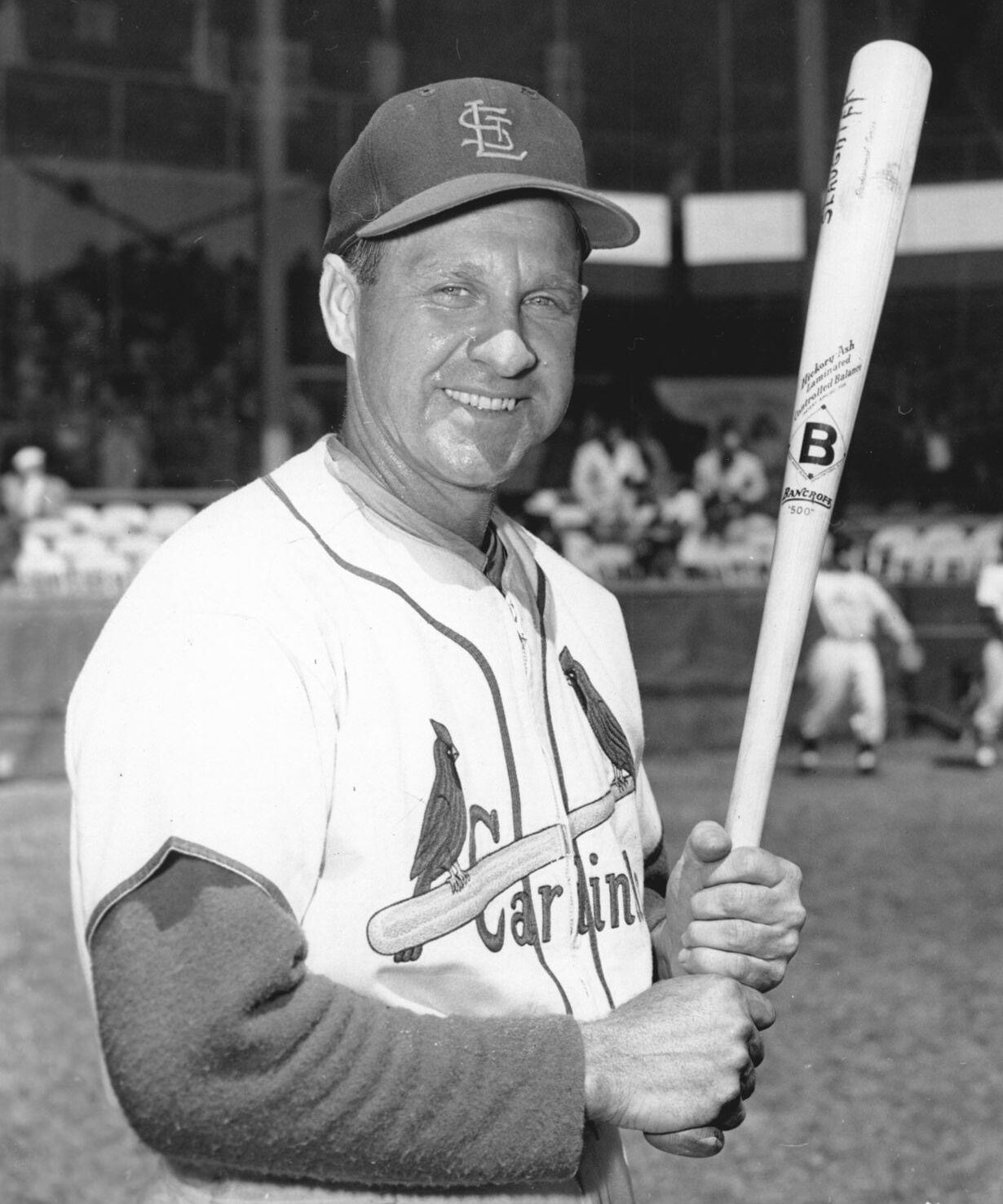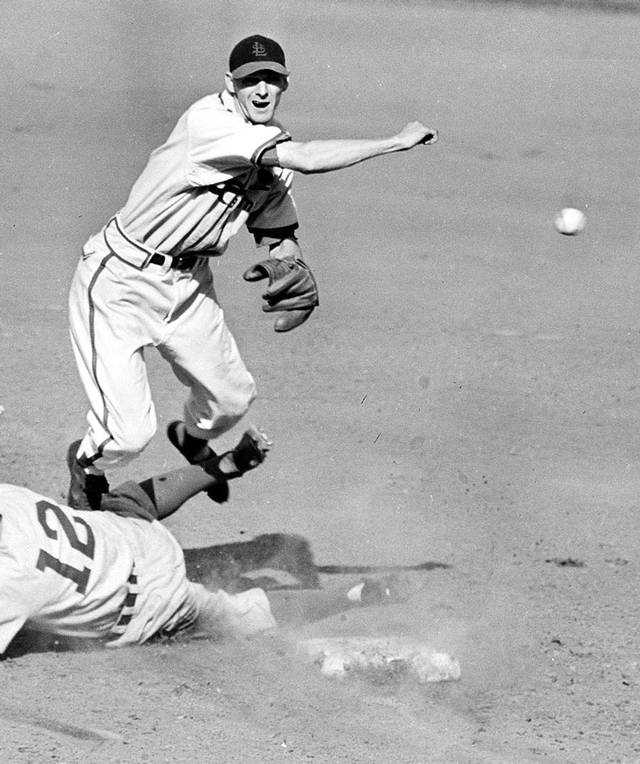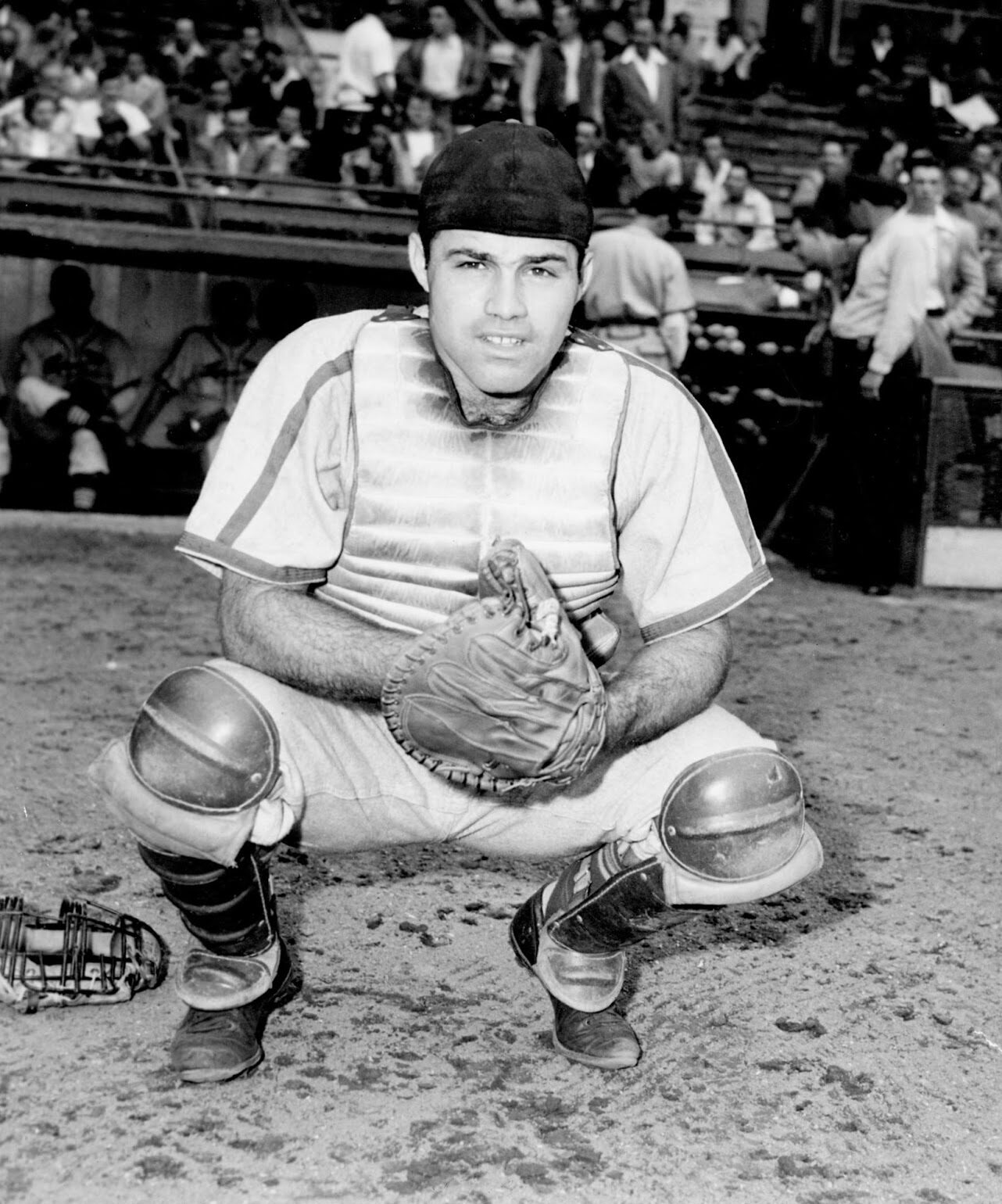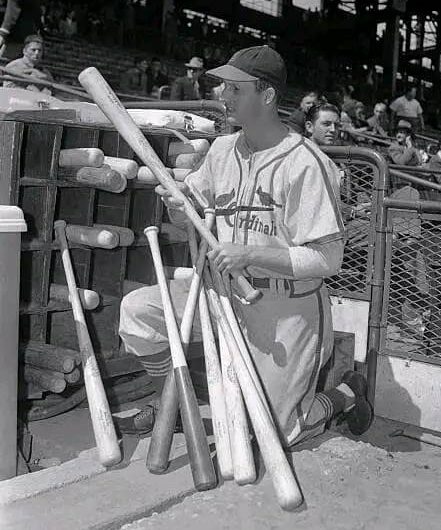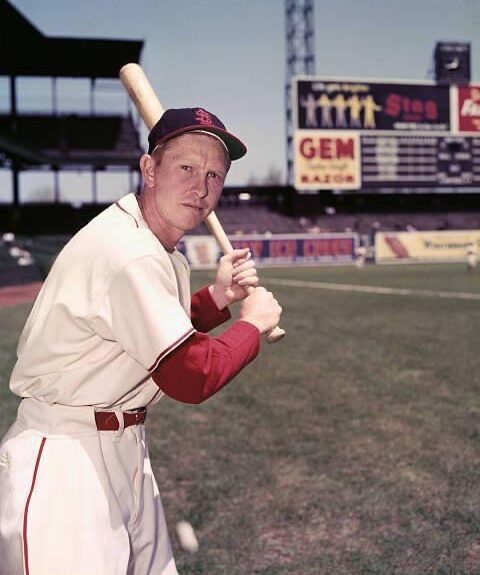Harry Brecheen
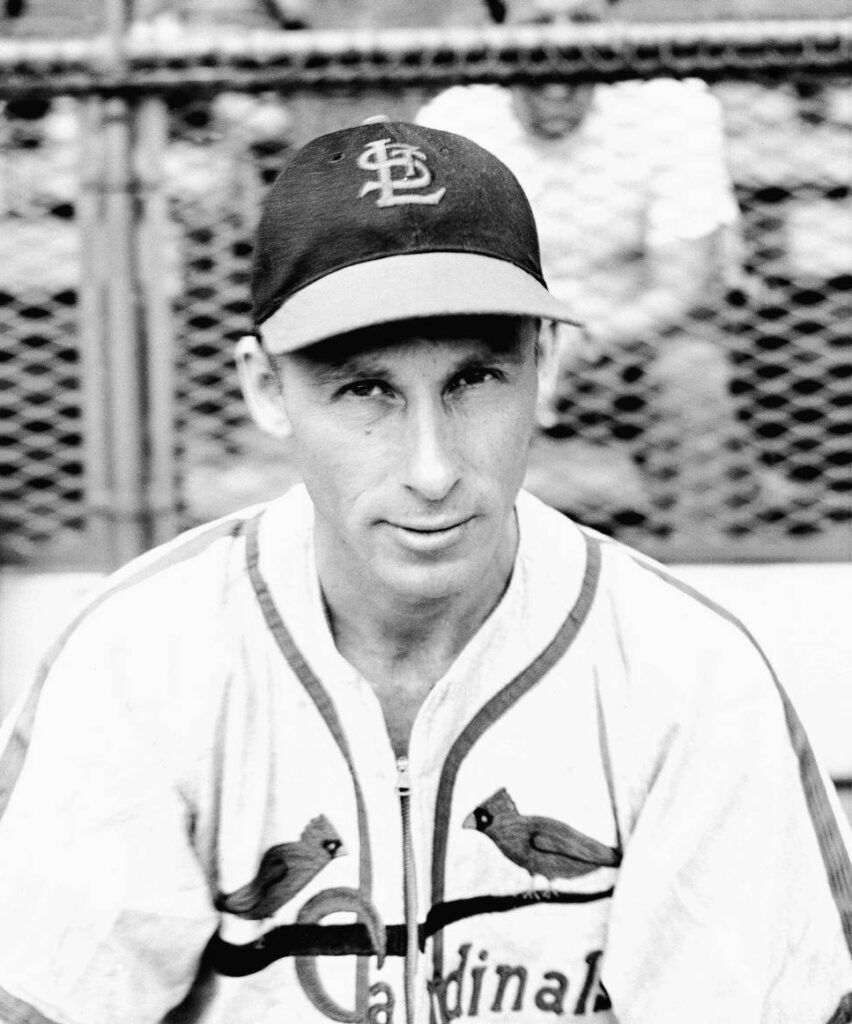
| Birthdate | 10/14/1914 | |
| Death Date | 1/17/2004 | |
| Debut Year | 1940 | |
| Year of Induction | ||
| Teams | Browns, Cardinals | |
| Position | Pitcher |
Harry Brecheen won 3 games in the 1946 World Series; overall in Fall Classic play he went 4-1 with 3 complete games, a shutout, and an 0.83 ERA.
Leave a commentIn the collection:
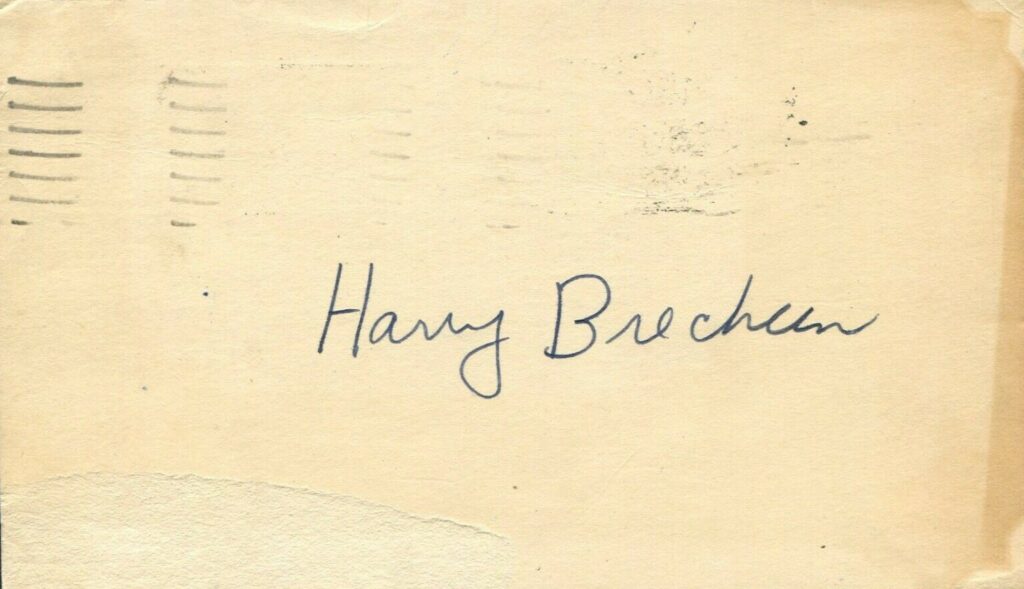
Two-time All Star Harry Brecheen won 20 games in 1948; he led the NL in ERA, Ks, shutouts, & WHIP
Two-time All Star Harry Brecheen won 20 games in 1948; he led the NL in ERA, Ks, shutouts, & WHIP

Harry Brecheen began his professional career in 1935 as a 20-year old in the Texas League. With the exception of a three-game stint with the Cardinals in 1940, Brecheen spent the next 8 years in the minors.
When World War II thinned out the talent in the big leagues, St. Louis put the 5’10”, 160-pound lefty on their roster for 1943. His 29 appearances included 13 starts, 8 complete games, 9 wins, 4 saves, and a nifty 2.26 ERA. Brecheen’s performance helped the Cardinals win 105 games and the National League Pennant.
A fine fielder with quick reflexes, Harry completed the ’43 season without making an error. St. Louis writers soon tagged with the nickname, “The Cat”. The moniker stuck.
Harry blossomed in his second full big league season, going 16-5 with a 2.85 ERA. The Cardinals repeated as NL champs. When the Browns captured the AL flag, the ’44 Fall Classic became an all-St. Louis affair.
The Browns won two of the first three. With their season on the line, the Redbirds pinned their hopes on Brecheen. He responded with a complete-game one-run effort. The Cardinals rode the momentum, winning the next two games to capture the franchise’s 5th World Series title.
From ’43 until ’45 when the war ended, Brecheen went 40-15, with 34 complete games, 7 shutouts, 6 saves, and a 2.58 ERA. Some in baseball believed his success was because of the depleted talent due of the war.
Brecheen proved them wrong. As players returned from military service, the quality of the competition improved. So did Harry.
In 1946 he led the NL in shutouts, had a 2.49 ERA and received votes in MVP balloting. The Cardinals won 98 games and again reached the World Series, this time against the Red Sox. Brecheen was at his best.
Boston won the first game. In his Game 2 start, Brecheen twirled a four-hit shutout to even the Series. The Fall Classic was a seesaw affair with the Red Sox winning Games 1,3, and 5. On the brink of elimination in Game 6, St. Louis turned to The Cat.
The southpaw answered the call by again going the distance, quieting the potent Boston lineup in a 4-1 St. Louis victory. In the deciding Game 7 the game was tied 1-1 when the Cardinals pushed across two runs in the 5th inning. Boston rallied in the 8th, putting the tying runs on second and third before recording an out.
With Cardinals starter Murry Dickson on the ropes, skipper Eddie Dyer made a gutsy call, beckoning Brecheen out of the bullpen. The reliable lefty was taxed. He already pitched two complete games in the Series, the last coming just two days earlier.
Harry immediately retired Wally Moses and Johnny Pesky. Up stepped Boston centerfielder Dom DiMaggio who poked a hit to right that scored both of the runners Brecheen inherited. The game was tied.
In the top of the 9th Enos Slaughter singled to lead off the inning. After two out Slaughter was still stranded at first base. With Harry Walker at bat, manager Dyer called for a hit-and-run.
Walker lined the ball into centerfield. Running with the pitch, Slaughter quickly rounded second. A he headed to third, he encountered a stop sign from coach Mike Gonzalez. Slaughter ignored the instruction and made his famous Mad Dash to score the go-ahead run. Brecheen got the final three outs to earn his third win of the Series and give the Cardinals the title.
The Cat followed up his stellar World Series performance in ’46 by making his first All Star team in ’47. Then he had his finest season in 1948.
A 20-game winner, Brecheen led the Senior Circuit with a sparkling 2.24 ERA. He also posted league-leading and career-best numbers in shutouts, strikeouts, and WAR. Brecheen finished 5th in the MVP race behind winner and teammate Stan Musial.
Although he began to slow from there, Brecheen tallied 35 complete games, 5 shutouts, and 6 saves from 1949-1952. The Cat switched leagues for 1953 but stayed in St. Louis with the AL’s Browns. In his final season at age 38, Brecheen made 16 starts and 10 relief appearances for the last-place, 100-loss Brownies. His 3.07 ERA was the best on the staff.
Harry retired at the end of ’53, calling an end to a fine career. Though he wasn’t in the big leagues to stay until age 28, Brecheen won 105 games in his first 7 full seasons. Seven of The Cat’s 12 MLB seasons were errorless efforts. In fact, he committed just 8 miscues in 1907 2/3 innings of play.
The postseason hero finished went 4-1 with an 0.83 ERA in World Series play. His career WAR stands at 42.2, higher than Cooperstown men Catfish Hunter, Bob Lemon, Jess Haines.
After calling it quits as a player in 1953, Brecheen remained with the Browns franchise for 14 years as pitching. The team relocated to Baltimore and became the Orioles in his first year on the job. The franchise went from one of the AL’s worst teams to one of its most respected.
The Orioles pitching staff ranked in the AL’s top four in ERA ten times under Brecheen’s watchful eye. Baltimore pitchers led the Junior Circuit in ERA four seasons during Brecheen’s tenure. In 1966 they beat the Dodgers to win the World Series.
Brecheen left the game for good in 1967. Thirty years later the Oklahoma native was named to his state’s Sports Hall of Fame. Harry “The Cat” Brecheen passed away in 2004 at the age of 89. In 2018 he was posthumously inducted into the Cardinals Hall of Fame.
In the collection is this government postcard signed by Harry “The Cat” Brecheen in 1948.
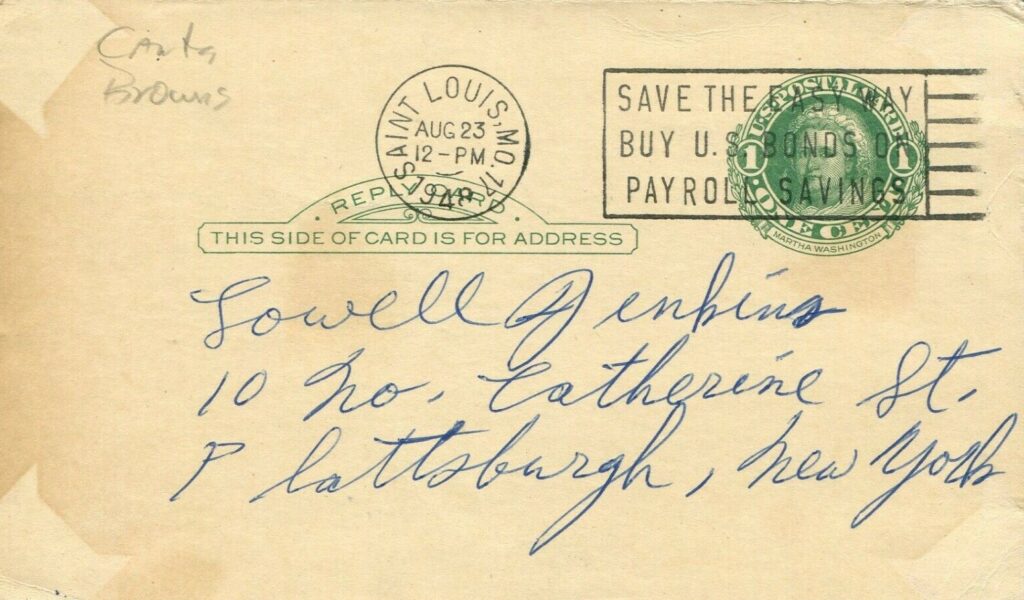
Harry Brecheen's career 133 ERA+ is surpassed by just 33 pitchers in MLB history
Harry Brecheen's career 133 ERA+ is surpassed by just 33 pitchers in MLB history

Just how good was Harry Brecheen? By at least one measure, he was among the game’s all-time elites.
In the history of Major League Baseball, only 33 men have a higher career ERA+ than The Cat. So just what does the stat mean?
According to MLB.com, “ERA+ takes a player’s ERA and normalizes it across the entire league. It accounts for external factors like ballparks and opponents. It then adjusts, so a score of 100 is league average, and 150 is 50 percent better than the league average.”
Now comparisons can be made across era. During his dozen years at baseball’s highest level, Brecheen was 33% better than the league average. The overwhelming majority of those ahead of him are either in Cooperstown or well on their way.
Brecheen’s run-prevention was truly elite. It was also remarkably consistent. In 8 of his 10 full seasons he was at least 22% above league average. He led the league with a 182 ERA+ in 1948.
Shown here is the reverse of the government postcard signed by Harry Brecheen in the league-leading campaign. Notice the USPS postmark from Saint Louis, Mo., dated August 23.
A quick glance at The Cat’s game logs from ’48 shows that he pitched a 4-hit shutout in his last start before dropping the card in the mail. The August 19th contest against the Reds was Brecheen’s 15th victory en route to his only 20-win season.
Government postcards provide great context to a signature. This one came from a few days after one of baseball’s historically-good run preventers pitched a shutout in the summer of his best season.
